|
|

|
An Eye On The Earth
Dave Scott and pure test piloting
By Francis French
October 4, 2002
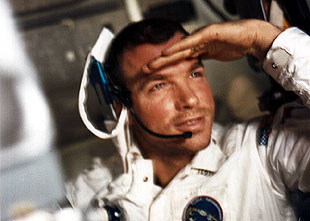
As commander of the flight of Apollo 15 in 1971, astronaut Dave Scott led one of the high points of human exploration. For three days he investigated the lunar surface, spending 21 hours outside the Lunar Module during the first extended scientific expedition of the Moon. As space flight historian Tim Furniss wrote, "Dave Scott's Apollo 15 mission was the pinnacle of the American achievement. After Apollo 16 and 17, which were essentially duplicates... nothing of comparable challenge, risk or reward has emerged since."
It was truly exploration at its greatest - and yet it is often overlooked that Scott flew two prior missions which were even more important in advancing the technology and techniques that made lunar exploration possible - Gemini 8 and Apollo 9.
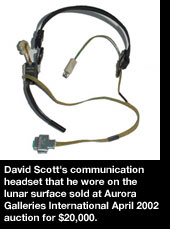 I met with Scott last April at the Museum of Flying in Santa Monica, California, where he was a guest at the first space memorabilia auction of Aurora Galleries International. Along with a number of other astronauts and cosmonauts, Scott was selling items of his own, such as flags, patches and medallions flown on his missions, his Apollo 15 EVA suit nametag, a Lunar Rover license plate and even the communication headset that he wore on the lunar surface. I asked him what made him decide to part with these objects at this point. I met with Scott last April at the Museum of Flying in Santa Monica, California, where he was a guest at the first space memorabilia auction of Aurora Galleries International. Along with a number of other astronauts and cosmonauts, Scott was selling items of his own, such as flags, patches and medallions flown on his missions, his Apollo 15 EVA suit nametag, a Lunar Rover license plate and even the communication headset that he wore on the lunar surface. I asked him what made him decide to part with these objects at this point.
"I don't know - it beats me! They are just objects to me. I have kept some artifacts, of course. Members of the family are taken care of, that is no problem. There is no sense in leaving other things buried in a box somewhere. This way, people can enjoy them, and they become a part of history. This was my 'was' life, and I am now in my 'is' life. I've got a different life now, and I don't do these things - I don't really have the time to! Life is so compressed, there is not enough of it. Shoot, I have forgotten ninety percent of what people did, because life goes on!"
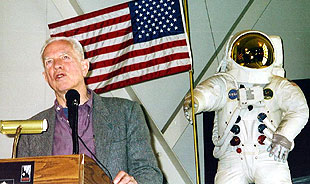
Despite having moved on from his NASA career many decades before, Scott was enthusiastic about what Aurora auctions was doing. Surrounded by the Museum's space exhibits and items for auction such as a Russian Sokol Spacesuit, flown Vostok spacecraft instrumentation and Dick Gordon's flown Apollo 12 flight suit, Scott explained the importance of such events.
"This is an interesting and important occasion. The auction catalog is really a pretty good historical document - you can pull a lot of things out of there of what happened, what people did. I see it as a catalog of history. When we go back in future years and try and decide how Apollo actually happened, I think a lot of these artifacts will be very important to historians - to try and understand how we did it, and perhaps try and do it again to some other destination.
"I see this as a beginning of exploration outside the Earth, and perhaps outside of the solar system. But I think that will take many years - hundreds of years, in fact - and that makes such memorabilia and history even more important. It is especially important to get it accurate, because by the time people go back out to the Moon, on to Mars and other planets, they'll have this to look back on and understand the techniques and methods that we used. At that time, I am sure it will be like how we look at the very early airplanes and wonder, my goodness, how did they ever get these to work?"
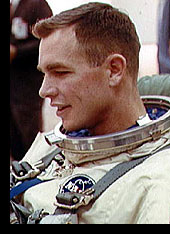 The son of an Air Force general, Scott earned a Masters' Degree in aeronautics and astronautics, specializing in interplanetary navigation, while training as an Air Force fighter pilot and test pilot. With the perfect background for the job, he was selected to join NASA in 1963 with the third group of astronauts. Very highly ranked by his peers, they described him as "All-American," and joked that Scott came closest to the public persona of the tall, rugged, patriotic cold-war hero - looking most like the movie version of a daring astronaut. Over thirty years later, Scott still has that air about him; although time has altered his features, he now bears a striking resemblance to another American icon, the actor Lee Marvin. The son of an Air Force general, Scott earned a Masters' Degree in aeronautics and astronautics, specializing in interplanetary navigation, while training as an Air Force fighter pilot and test pilot. With the perfect background for the job, he was selected to join NASA in 1963 with the third group of astronauts. Very highly ranked by his peers, they described him as "All-American," and joked that Scott came closest to the public persona of the tall, rugged, patriotic cold-war hero - looking most like the movie version of a daring astronaut. Over thirty years later, Scott still has that air about him; although time has altered his features, he now bears a striking resemblance to another American icon, the actor Lee Marvin.
"Becoming an astronaut was an evolution - I was a fighter pilot, went through test pilot school, and then NASA put out a request for applications for the third group of astronauts. Everybody in my peer group applied. So it was an evolution - it was not something we really looked at as a career objective, as it did not really exist then! We had a physical exam, which lasted for about a week, where they poked and probed everything in the body. We had interviews, a written exam in Houston - general questions about aeronautics, airplanes and space. It was a pretty thorough examination, and there were never any scores published."
With Scott's test piloting credentials, it was little surprise to his peers that he was the first of that group to go into space, as pilot of Gemini 8. Scott had concentrated on spacecraft guidance and navigation during his training, which fit the mission's objectives perfectly. Indeed, Mike Collins later wrote that seeing Scott picked first reassured him that NASA knew what they were doing.
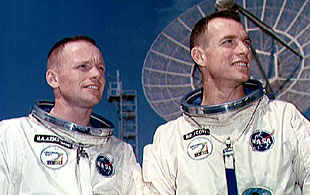
Under command of Neil Armstrong, the mission was to rendezvous and dock with an Agena rocket target. The docking would be the first of the American manned space program, and an important step if flights to the Moon were ever to be made. Some astronauts were still unsure as to whether it could even be done flying manually, likening it to the difficult and complex process of aircraft mid-air refueling.
The flight plan also called for Scott to make the second American EVA. This spacewalk was planned to last for two hours, with Scott strapping on an Extravehicular Support Package (ESP) and maneuvering gun and floating over to the Agena, while remaining tethered to the Gemini spacecraft.
As the launch day approached, there was concern within NASA over the Agena rocket's reliability - one had blown up in a test only a few weeks before. Mission Control instructed the astronauts to "get out fast" if the Agena showed any signs of malfunction. Scott shared the concern.
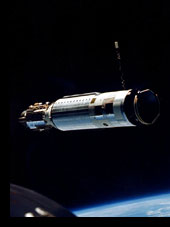 "Gemini had a pretty good computer. For its day, it was a pretty spectacular spacecraft. But I had a lot of concern about the Agena. In those days, the hardware was very new, and there were a lot of things happening. We had to make the assumption that it was okay, but during the flight they did see some problems with it, or thought they did." "Gemini had a pretty good computer. For its day, it was a pretty spectacular spacecraft. But I had a lot of concern about the Agena. In those days, the hardware was very new, and there were a lot of things happening. We had to make the assumption that it was okay, but during the flight they did see some problems with it, or thought they did."
There was also some concern that two docking spacecraft launched from different places might exchange a dangerous electrical charge, and one of this mission's tasks was to evaluate that possible hazard. This turned out not to be a problem - although the mission did culminate in the first serious space emergency.
"I think it was not so much the different orbital paths, but launching from different spots on the Cape, where the electrical potential was different. We were also launching ninety minutes apart, where there might have been a buildup on the second spacecraft, due to lightning or something else, that the other one did not have. But nothing happened - we did not see a single spark."
Gemini 8 lifted off on March 16, 1966, to rendezvous with the Agena, which had been launched earlier. It was the first time that two space vehicles were simultaneously counted down and launched at the precise second planned.

Once in space, Armstrong matched orbits with the Agena, and Scott spotted it shining like a star from 76 miles away. Within six hours of launch, Gemini 8 had achieved rendezvous with their Agena target. Half an hour later, Armstrong began the docking, using the Gemini thrusters to move in from a distance of fifty feet.
As Armstrong moved Gemini into Agena's docking collar, in a procedure that Gus Grissom described as similar to "slipping a car into a garage," the first manned space docking was achieved, and with it one of the major aims of the Gemini program. Earlier concerns about electrical discharge between the spacecraft proved to be an non-issue. Armstrong described the docking as "a real smoothie."
With the communications station in Zanzibar closed as a result of political troubles, the spacecraft was out of communication with ground controllers for the dramatic events that followed. The Agena had been instructed to fire its control thrusters in order to keep the two spacecraft at the same angle respective to the direction of orbital travel. As Gemini 8 was passing out of communications range the astronauts were instructed to turn Agena's thrusters off and take control of the spacecraft if this proved not to work.
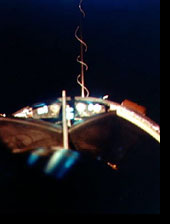 The docked spacecraft were in darkness, so it was only with instruments that Scott noticed they had yawed thirty degrees from their planned position. Armstrong also took a look, and confirmed this. Armstrong then moved the two spacecraft back into the correct position using Gemini's thrusters. However, as soon as he released the hand control, the docked spacecraft resumed their unwanted motion. With no telemetry information from Gemini or Agena available via Mission Control to help explain this, the astronauts had to analyze the problem on their own. The docked spacecraft were in darkness, so it was only with instruments that Scott noticed they had yawed thirty degrees from their planned position. Armstrong also took a look, and confirmed this. Armstrong then moved the two spacecraft back into the correct position using Gemini's thrusters. However, as soon as he released the hand control, the docked spacecraft resumed their unwanted motion. With no telemetry information from Gemini or Agena available via Mission Control to help explain this, the astronauts had to analyze the problem on their own.
"The first indicator was seeing Neil's eight-ball at about a thirty-degree bank. I looked at mine, and it was at a thirty-degree bank too. He looked and said yeah, we were rolling. We thought that the problem was with the Agena at the time. Mission Control had said, 'Watch out for the Agena, we think we have a problem. If anything happens, shut it down.' Which we did."
Both astronauts felt the problem lay with the Agena's control system thrusters, so Scott sent and continued to send shutdown commands to Agena's attitude control. However, this did not solve the problem - in fact, as well as yawing, the connected vehicles now began to spin together. Worried that the docking adapter connecting them might break, they used their thrusters to slow the spin enough to undock. Scott hit the emergency release, while Armstrong fired the thrusters.
Unknown to the astronauts, however, the thruster problem was with Gemini, not Agena. Now separated from the other vehicle, things only got worse aboard Gemini. The spacecraft had now shed almost half of the mass attached to it, and began to roll and tumble even faster, until it was spinning once a second. Armstrong and Scott's vision began to blur, and their heads banged together.
"It was a busy time, trying to sort out the problem. We were getting close to tunnel vision. When you can't see, you can't do anything. Up at one point, we were spinning more than once per second - but the whole process was going on for about twenty minutes. It was not so much a sideways motion, more a rotational roll movement. I was very close to blacking out.
"Once we'd have blacked out, it would have been over. We'd never have remembered, never have known. We weren't consciously thinking about that, as there was no time to. We were thinking about how to solve the problem. We went through all the procedures, talked about the problem and how to fix it. You don't think about, 'Oh my God, what if we don't fix it?' You don't think about that - you go fix the problem.
"A thruster was firing intermittently on and off. It would fail to fire when it was commanded on - so it was not a linear situation. The thrusters at that time were designed such that when you wanted to open the valves, you applied a ground. They were hot all the time. So if there was a grounding somewhere, it would fire. There was a sequence."
The astronauts faced the grim possibilities of colliding with the Agena while spinning, losing consciousness, or having the spacecraft spin beyond its structural strength. With blurred vision making it difficult to see individual thruster switches, they shut down all sixteen OAMS thrusters, used to change orbit and attitude. However, with no atmosphere or gravitational effect to slow the relentless rolling, simply stopping the thrust did not slow them at all.
With no time left to work out which OAMS thruster caused the problem, Armstrong had to use the spacecraft's other thrusters, the RCS re-entry system, to stop the rotation before they lost consciousness. Finally the spacecraft's roll slowed, then stopped. When Armstrong began to individually test the OAMS thrusters, the rolling began once more. Something was short-circuiting within the system that controlled them, causing a 23-pound thruster to fire at first intermittently, then continuously.
As the radio antenna was spinning with the spacecraft, communication with the ground was almost impossible. Chris Kraft in Mission Control later admitted to feeling frightened and helpless, having two astronauts "alone up there with an out-of-control spacecraft." Armstrong and Scott, however, were both test pilots, and used to solving problems independently.
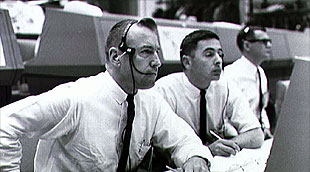
"The ground could not have done a thing, even if we had been able to talk to them. There was not any time. Besides, with the spinning, we would not have been able to have constant communications, and they wouldn't have been able to react fast enough to do anything. Once a tumble started, regardless of where Mission Control was, they were out of the picture. Just like if an airplane gets into a spin, it doesn't matter what a ground radar site does or sees. They are not part of the equation. This is split-second stuff, where you have to make a decision, and you make it."
Mission rules stated that once the RCS reentry thruster control system had been activated, Gemini had to return to Earth immediately. Much of the fuel reserved for reentry had already been used saving their lives, so this seemed like a wise plan to follow. A fleet of recovery ships rushed into position as the two astronauts prepared for a hurried return. The Gemini spacecraft splashed down in an emergency recovery zone in the western Pacific ocean, having been in space for almost eleven hours.
"We were ready to keep going with the mission at the time - but probably not really, in retrospect. Realistically, we had used up about half of the reentry control system fuel, and we knew it was time to come back. After Gemini 8, they reversed the thruster polarity so that subsequently, the thrusters would come on when you applied power. It was a learning process!"
As Gus Grissom wrote, "Gemini 8 reminded the public, briefly, that space flight was not yet as simple as a ride on a trolley car." Frank Borman put it even more starkly when he said "they damned near became the first U.S. casualties in space."
Scott was very disappointed to have lost the opportunity to conduct the EVA that he had trained so long and hard for. Later in the Gemini program, when Gene Cernan and Dick Gordon encountered great difficulty in carrying out simple maneuvering on spacewalks, some felt that the Gemini 8 EVA plan would have been too ambitious. Scott, however, does not agree.
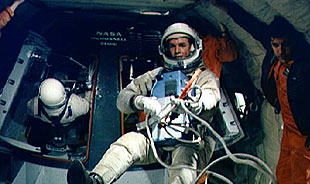
"I think that there were some other factors on Gemini 9 and Gemini 10 that complicated what they were trying to do. I think basically the plan was well laid out, well rehearsed. You have to remember that the Gemini 9 crew did not really have a chance to get ready early, because of the loss of Bassett and See. So we had more time to prepare on Gemini 8. Neil Armstrong is a taskmaster, and made everyone do everything, even in the chamber. We even had an anti-fog compound that 9 did not have. So I think we were prepared. Had we not had to come down early, I am fully satisfied that we would have got everything done. It was a great disappointment that I did not get to do that EVA."
Scott had shown incredible presence of mind during the unexpected events of the Gemini 8 mission. Even in the middle of an emergency, out of contact with Mission Control, he had re-enabled ground control command of the Agena before the two vehicles separated. This meant that for the following two days, the ground could thoroughly test the Agena's thrusters and ensure that it had not been to blame. The skill Scott had shown was reflected in the fact that, only five days after returning from Gemini 8, he was assigned to an Apollo crew.
In those days there was a keen competitiveness in the astronaut program. Gene Cernan has stated that astronauts were always looking for ways to criticize each other, so that they could get further up the line of those waiting to make a space flight. Some in the astronaut office tried to apply this to Armstrong and Scott, as their mission had not completed all of its objectives. The criticism did not have the desired effect - in fact in Armstrong's case, he obtained perhaps the most coveted assignment of all, command of the first lunar landing. However some space historians have speculated that Scott was left feeling he had something to prove - he wanted a successful flight.
"I just felt like I needed to have a full mission! Not the specific performance of events - but I was looking forward to Apollo 9, and a complete mission, rather than Gemini 8's partial mission. Apollo 9 was a great opportunity for me. I got the three best missions in the books, and 9 was certainly one of them."
The mission that eventually became Apollo 9 was the first manned mission to fly all the elements needed to land on the Moon - the Saturn V rocket, the Command and Service Module, the Lunar Module, and the suit that would be worn to explore the Moon's surface. It would therefore be the first demonstration of the entire Apollo system's integrity. The mission was not going to fly to the Moon - it would not even leave Earth orbit. It would, however, be just as risky as sending a Command and Service Module around the Moon - perhaps even riskier. For the first time, astronauts would be flying a spacecraft that had no heat shield, and thus no way to return to Earth safely.
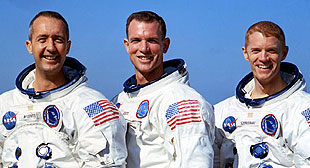
The Command Module Pilot for this mission would need to be extremely reliable and have the proven ability to stay cool under pressure. Deke Slayton therefore had no reservations in selecting Dave Scott for this task, as he had displayed these qualities admirably on Gemini 8. Scott would be flying with Lunar Module Pilot Rusty Schweickart, both under the command of Jim McDivitt. By the time of the flight, they were one of the best-trained crews ever launched, since they had been training together since January 1966, originally as the backup crew for Apollo 1. Whatever changes were made to the flight rotation following the fire, McDivitt and his crew always kept the assignment to fly the first Lunar Module.
Gene Kranz is one who agrees that they were the best prepared of any Apollo crew. In his autobiography, Kranz is particularly complimentary of Dave Scott's performance: "Scott knew his spacecraft better than any prior Command Module Pilot. If he had to initiate a rescue attempt, you could be damn sure he would have succeeded."
One major change in the Apollo flight schedule occurred before Apollo 9 flew. With serious reports that the Russians might send a cosmonaut around the Moon at any time, it was decided to alter the sequence of flights and send Apollo 8 to the Moon. As McDivitt's crew were next in line when the mission was altered, McDivitt was given the option of keeping his crew's place in the flight order and making the first flight to the Moon, or staying with the mission he had trained for and flying the first Lunar Module. He elected to stay with his mission - and only discussed it with his crewmembers afterwards. Some astronauts, such as Gene Cernan, were extremely surprised - Cernan believed that the whole point of being an astronaut was to go to the Moon. Scott, however, had no problem with carrying out the mission he had trained for.
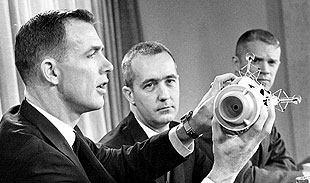
"Jim told us that he had made the decision, what did we think? We agreed one hundred percent. If before the mission I had the choice of 8 or 9, I would have taken 9 without even thinking about it. Nine was a full mission, with a lot of challenges and opportunities. Eight was a pretty simple mission in terms of what the crew did. The probability of actually going all the way out and around the Moon, we figured at the time was about fifty percent. Not that they would die, but just because of the things that had to be done.
"At the time, we knew how glamorous Apollo 8 would be. It turned out to be very glamorous. But again, the objective at the time was to get to the Moon. Apollo 9 was the first full test flight of the full Apollo equipment. So I would have taken 9 before 8 without even a second thought, and I am sure Rusty would have, too."
Indeed, Apollo 8 is remembered far more often in the history books than Apollo 9, which was never destined to be one of the "glamorous" missions. In his autobiography, Walt Cunningham stated that, "An Apollo family portrait would picture 9 as an engineering student standing between 8 and 10, two strapping glamour-boys who traveled to the Moon." Mike Collins also wrote that the public found it hard to understand why, having gone to the Moon, Apollo would next be "tooling around in Earth orbit" again. Scott describes it as "a test flight, a pure test flight."
It was, however, a vital mission if Apollo was to land people on the Moon in a few months' time. Apollo 8 was perhaps more necessary from a psychological point of view - it demonstrated that people could leave Earth orbit and travel to other worlds. Apollo 9, however, was the vital key to proving that all of the years of hard engineering preparation would pay off - the machines all had to work together. If anything should go wrong, Apollo would probably not make a Moon landing before 1970. Scott, however, has no problem with the fact that Apollo 9 gets unfairly overlooked.

"You don't do this to be famous, you do it to accomplish a job. I think that the satisfaction we realized after Apollo 9 was more than adequate for our own benefits, goals and objectives. None of us got into the program, at least I don't think so, to be celebrities - that was not the point. Recognition for Apollo 9 was pretty high for the people who needed it. Certainly we were very happy about the mission, very satisfied. We were pretty happy!"
Even Gene Cernan conceded that this mission was a vital one, stating "this was what test piloting was all about - taking a totally untried machine out for a spin in which the only two possible conclusions were success or failure."
For the first time, an American manned mission would consist of two separate spacecraft - so identifying callsigns were needed for both. Over the protests of the NASA Public Relations department, the crew selected and stuck with two very practical names - Gumdrop and Spider.
"They were not chosen as names, they were callsigns - because they were crisp. At that time, names were not approved. But in the simulations, we had to have some sort of callsign - and they eventually evolved into names."
There was one sad note for Scott because of the change in flight order. He had worked hard on getting Command Module 103 into flight-ready condition, following it from the time it was a bare metal shell through all of the factory testing. He was not happy that the change in mission order meant he would now be flying CM 104, while CM 103 was flown to the Moon by the crew of Apollo 8.
"Damn right, that's for sure! I lived with 103 for a couple of years. On the other hand, I was very happy that it performed as it did. It was a great spacecraft - especially on that kind of mission, where it had to work!"
Scott was acutely aware, as the time to launch neared, that this mission had to succeed if Apollo 11 was to make a successful landing a few short months later.
"Oh yes, absolutely. There wasn't anybody pushing us on it - they didn't need to push us! We knew we had to do it. Everybody knew what had to be done. It was clear that this was the step that would allow us to walk on the Moon later that year - all of this had to be done, in order to make that work. And we did it!"
The mission was delayed while the three crew members all got over head colds; after the problems that stuffy heads had caused on Apollo 7, NASA did not want to repeat that experience. Apollo 9 was eventually launched on March 3, 1969. Unlike his Gemini experience, the Saturn V launch contained some surprises for Scott.
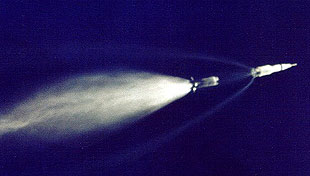
"Probably the biggest difference, if you pick out one point and make a single comparison, was the staging on Saturn 5 between the first and second stage. As John Young later described it, it was like a train wreck. It was just an absolutely violent, violent experience. Gemini did not have that. We were pretty well briefed on Gemini from the other guys, I think we felt pretty comfortable with what we experienced, based on what we expected."
A critical item for the astronauts to test was the docking probe and drogue, used to link the Command and Service Module with the Lunar Module. If the docking mechanism did not work after the spacecraft were joined, a lunar landing could not take place. If it did not work when the Lunar Module returned from the surface after a landing, the entire crew might never get back to Earth. This system was tested on the first day of the flight.
Once in orbit, Scott separated the Command and Service Module from the tapered adapter on the forward end of the Saturn S-IVB stage. The four sections of the tapered adapter opened "like huge flower petals," as Gene Kranz described it, looking "like something out of a James Bond movie." In a display of test piloting that had never been possible to attempt before, Scott turned the CSM around, nosed it into the top of the S-IVB and extracted the lunar module. Somewhat ironically, after the thruster problems of Gemini 8, some of the thrusters he had planned to use did not immediately work - but Scott did the job perfectly. The probe and drogue worked.
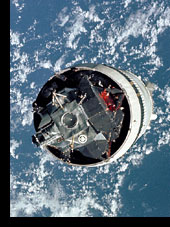 "The turnaround had never been done before, manned or unmanned. There had never been a launch of the CSM and the LM before, so there had never been a transposition and docking. The only command modules that had flown were on 7 and 8, and neither of them had any docking capability. A lot of things had to go right to make it work. It did not go as expected - but it was not because of thruster switches, as it is told in some people's books. It was because somehow, during the sequence of shocks from launch through the separation of the Command Module from the adapter, the valves closed due to the shock. It was not the switches, because we checked the switches. Unfortunately, people thought when we got back down - and some books say this - that we had bumped the switches. No, the valves shut on those thrusters from the shock, as they found out later on. When we figured out what the problem was, we just cycled the switches, and they opened." "The turnaround had never been done before, manned or unmanned. There had never been a launch of the CSM and the LM before, so there had never been a transposition and docking. The only command modules that had flown were on 7 and 8, and neither of them had any docking capability. A lot of things had to go right to make it work. It did not go as expected - but it was not because of thruster switches, as it is told in some people's books. It was because somehow, during the sequence of shocks from launch through the separation of the Command Module from the adapter, the valves closed due to the shock. It was not the switches, because we checked the switches. Unfortunately, people thought when we got back down - and some books say this - that we had bumped the switches. No, the valves shut on those thrusters from the shock, as they found out later on. When we figured out what the problem was, we just cycled the switches, and they opened."
The second day of the flight was taken up with maneuvering tests, and the third with a thorough checkout of the Lunar Module. They proved that the two spacecraft could be moved together when the Command and Service Module's engines were fired. The fourth day was supposed to see Rusty Schweickart make an EVA from the LM over to the Command Module - however, he had been plagued by bouts of nausea, and there was concern over what might happen should he be physically sick inside a spacesuit helmet.
"They didn't know much about space sickness at that time, though a lot of guys had discussed it. The reason it became visible this time is that it impacted the timeline. At the end of the day, Rusty did everything he was supposed to do, and he felt fine. He just had to get past it. He could have done the whole EVA, gone all the way. But on the other hand, it was not really necessary. He did what he needed to do. The rest of it was sort of academic - to have gone all the way to the Command Module. Staying with conservatism was okay. Jim said okay, that's enough, we have proved the point - and he was right."
Instead of carrying out the full EVA plan, Schweickart stood on the LM's front porch, while Scott did a forty-five minute stand-up EVA in the open Command Module hatch and brought in experiments that Schweickart had been scheduled to recover. Because of a camera malfunction, Schweickart had the luxury of taking in the awe-inspiring sight of Earth passing below him with no tasks to distract him, an experience that profoundly changed his outlook on life. Scott got to take a quick look, too.
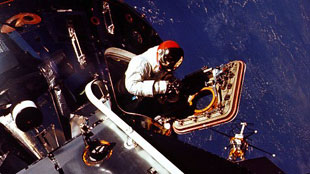
"I had a jammed camera, and I was working on that while he was taking in the view. The camera was the same camera that didn't work on almost every mission! But I had time to look out - we both did. Once he got outside, there wasn't much more for him to do, until we got close to sunset."
The fifth day of the flight brought the ultimate test of faith in the hardware - the separation of the Lunar Module from the Command and Service Module. With McDivitt and Schweickart in the Lunar Module, Scott stayed alone in the Command Module, hitting the switch that separated the two spacecraft. For the first time since the Mercury program, an astronaut was flying a spacecraft solo. Scott kept the Command and Service Module in a circular orbit, ready to complete a solo rendezvous and rescue if needed, while the Lunar Module tested maneuvering into different orbits. Scott watched as the LM diminished to a bright star, until finally it was 100 miles away and lost to sight.
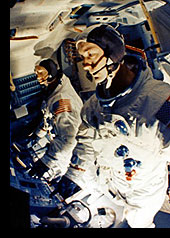 Although in a spacecraft with no heat shield, Schweickart felt safer than he did during altitude chamber tests in Houston. He found the LM to be crisply responsive to the controls, more so than the CSM - like the difference between a fighter and a transport plane. He preferred the uncluttered feel of the spacecraft, too, and the feeling of flying while standing up. Although in a spacecraft with no heat shield, Schweickart felt safer than he did during altitude chamber tests in Houston. He found the LM to be crisply responsive to the controls, more so than the CSM - like the difference between a fighter and a transport plane. He preferred the uncluttered feel of the spacecraft, too, and the feeling of flying while standing up.
Once the LM had been thoroughly test-flown as an independent spacecraft, Gumdrop and Spider matched orbits once again in the most complex space rendezvous to date, ready for docking. The rendezvous duplicated as closely as possible the flying techniques needed for a crew to ascend from the Moon and dock. At this point, another problem occurred. The sun was shining directly through the window which McDivitt needed to look out of, making it extremely difficult for him to see well enough to dock. It was later decided that the Command Module Pilot should perform that maneuver on subsequent missions.
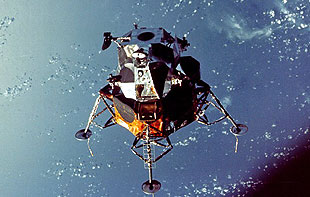
"I had to guide him in a little bit. The LM was designed with the upper window. When you fly through the upper window, you had to basically cross-control the inputs to the controls mentally. That is very difficult, and looking up makes it harder. We realized it was really much easier for the Command Module to do the active docking. Jim would have made it anyway, even if the sun was shining in his eyes - he would have got there. But the procedure was changed after 9 to make the standard docking with the Command Module - it was so much easier. The LM would be a backup."
With this achieved, the last piece of the puzzle was in place - the two spacecraft functioned together, and it had been proven that astronauts could transfer back and forth between the two spacecraft.
"We had to prove it. If it didn't work, you had to go outside. If you are not docked, and you have to go outside - it's a tough job!"
The mission returned to Earth on the tenth day. Everything had worked so well that there was no need to fly any other tests in Earth orbit. The next Apollo mission went back to the Moon.
It has been stated in some histories of the Apollo program that Jim McDivitt wished to command another Apollo mission, but wanted to retain his entire Apollo 9 crew. Scott does not think this is the case, and McDivitt becoming manager of lunar landing operations in May 1969 was the deciding factor.
"I think that Jim opted out after 9, and we were then no longer a crew. Jim decided he wanted to go into management. Once Jim left for management, then there wasn't a crew."
Scott would not have to wait long to find another crew - and this time he would be the commander. He served as backup commander for Apollo 12, a mission which rounded out an incredible year for NASA. The first mission of the year had been Apollo 9, testing the lunar landing hardware for the first time. By the end of the year, that equipment had landed people on the Moon - twice. Scott believes he knows the reason why Apollo succeeded so fast and so well.
"In order to have a program such as Apollo, you need resources, and some sort of commitment. Not necessarily science, because scientists don't have enough money. Not necessarily technology, because technology will go along by itself. But unless you have a political commitment of some sort, you can't bring in the resources. The reason that happened on Apollo was because there was competition between the Soviet Union and the United States. In order to do something like that again, you need some source of commitment for the resources."
Backing up Apollo 12 put Scott in line to command the flight of Apollo 15. The fourth lunar landing mission, it would be remarkably different from the previous three.
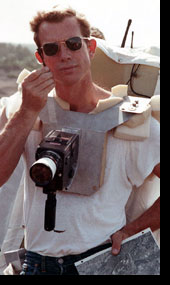 "Apollo 15 was the first extended scientific exploration of the Moon. We had to - it became time to do that. Often I like to compare it to a holiday. If you have studied a holiday destination, you can really enjoy it when you get there because you know something more about it than just the name. We had spent a lot of time studying the Moon, studying geology, and therefore we really enjoyed the scientific exploration as well as the scenery." "Apollo 15 was the first extended scientific exploration of the Moon. We had to - it became time to do that. Often I like to compare it to a holiday. If you have studied a holiday destination, you can really enjoy it when you get there because you know something more about it than just the name. We had spent a lot of time studying the Moon, studying geology, and therefore we really enjoyed the scientific exploration as well as the scenery."
Apollo 15 launched on July 26, 1971, and for the first time Scott left Earth orbit. His Lunar Module Pilot was Jim Irwin, and Command Module Pilot Al Worden would fly the Command and Service Module while the others explored the lunar surface - the system that Scott had helped test two years before.
"It took us three days to get to the Moon, we were in lunar orbit and on the surface for three days, and it took us three days to get home - twelve days in all. We had great food - but in the Lunar Module we ate everything that was there. There was nothing left! You work hard, you get hungry. Plenty of water, though, but we had to force ourselves to drink a lot of water. You work hard all day, you have to keep yourself from being dehydrated."
"We got back to normal physiologically in about two weeks. I lost about twelve pounds on the trip - a lot of it was water, and from eating high energy, low residue food. It's a great diet if you want to lose weight!
"The stars as you see them in space are very much as you see them out in the desert on Earth, with no lights or reflection around you, on a clear night. If the sun was behind you and you were looking through a window into the dark sky, you could see the stars. But there was reflection everywhere on the spacecraft and inside the spacecraft. On the dark side of the Earth, or the dark side of the Moon, you can see probably to sixth magnitude - so many stars you can hardly pick out the constellations. On the bright side, not so many. Standing on the lunar surface, maybe a few first magnitude stars."
Having learned from experience, including the Gemini 8 flight, NASA had prepared Scott well for any surprises.
"There were moments where we knew we had a problem, and knew we had to solve a problem. But there was always a way out - it was planned that way. In Mercury, they had a set of mission rules that were about twenty pages of bold-faced print. For Apollo 15 we had five hundred pages of six-point print! You learn as you go, plan for eventualities. Although there are surprises, the system seems to be able to take care of the surprises very well."
Scott and Irwin were heading to explore the Hadley Rille area of the lunar Apennines, an area of special geological interest.
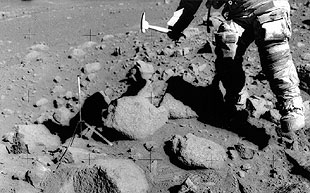
"Most of my thoughts on the Moon were of the geology involved. Our mission was especially heavy in science, trying to understand the geology of the local site and the Apennines - why things occurred as they did. We were there to collect samples of rock and soil and to substantiate what we were seeing. We also took a lot of photographs. It is mostly volcanic. We found a great variety of volcanic-type rock; everything from scoriaceous basalt to very fine-grained, dense basalt. We also found one crystalline rock, mostly anorthosite and plagioclase - that was one of our objectives. It was believed that the early formation of the Moon consisted of crystalline rock and slowly, during bombardment, it was covered with volcanic rock. We were looking for a piece of the original crust - which we apparently found.
"Consensus now says that the Moon was formed by the impact on the Earth of a giant body about the size of Mars. It disintegrated, taking pieces of the Earth with it, forming a ring of debris around the Earth which accreted into the Moon. Basically, the Moon is part of the Earth, and we found a lot of similarities in the chemistry."
Scott was eager to get to work exploring the Moon's geology, and thoroughly enjoyed the experience.
"It was not really a holiday - there was very little time to wander around and think. On the other hand, it is a wonderful place to work physically, because of the one-sixth gravity. It is rather easy to move about, except for moving the pressure suit. Once you get acclimated to the suit, it is just a marvelous place to work. It was exciting and challenging - a great opportunity. "
Scott and Irwin had another piece of hardware to test and to assist them in their explorations - the first lunar rover.
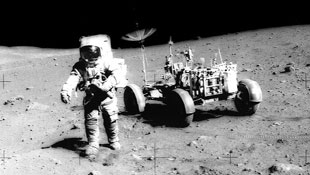
"The rover was superb - beyond expectations. It is amazing machinery - amazing that they could build it and apply it without ever testing it out in a one-sixth environment on lunar soil. It was built by Boeing in Seattle, and tested in terms of functionality rather than performance - because you couldn't build a rover for one-sixth G and operate it in one G. Similarly, if you built a rover that would work in one G, it would be far too heavy to work in one-sixth G. You could do functionality tests - would the battery drive a wheel, would the wheel turn? But you could not really test it to verify it on the Earth. It was a magnificent piece of engineering, a great little machine. We took the keys out and put them on the seat, with the handbook, if you want to try it!"
Although intently focused on the tasks to complete, Scott was sure to take in the alien landscapes he found himself working in - and also to look back at the Earth.
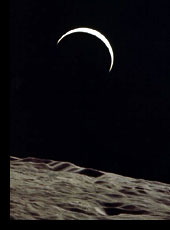 "It's a spectacular scene. The Moon itself is colorless, except for the shades of gray and black. You live on a planet with a black sky, no atmosphere. But it is a beautiful, marvelous place, especially if you understand where you are going. It really reminds you of how important the Earth is - it illustrates the uniqueness of the Earth and its importance to mankind. "It's a spectacular scene. The Moon itself is colorless, except for the shades of gray and black. You live on a planet with a black sky, no atmosphere. But it is a beautiful, marvelous place, especially if you understand where you are going. It really reminds you of how important the Earth is - it illustrates the uniqueness of the Earth and its importance to mankind.
"The view of the Earth from the Moon is really magnificent. If you stand on the Moon, look at the Earth and put your thumb up, the Earth disappears. I think I have a better appreciation for the Earth and the environment, because when you look back and see it, and realize it is the only place in the universe that we know of that humans can live, you know we have to take care of it. Even if there were other places in the universe, we can't reach them.
"The impact on me was to want to make people understand how important the Earth is, and that we need to take care of it - which we are not doing very well! I spend a lot of time now on environmental issues and ecology, because of understanding that importance. Probably the significance of the Apollo program was not so much putting a foot on the Moon, but putting an eye on the Earth."
Scott believes that the next step in exploration beyond the Moon may not involve humans as direct participants at all.
"The Space Station will probably be a one-off thing, though it will be there for a long time. It does useful research, but to extend beyond a space station takes so much in terms of resources and commitment, it is difficult to see how that is going to happen without a competitive issue, or something else to drive it. The next step in space exploration should be robotic exploration of all of the planets. I think we learned how to explore the Moon with humans, and now we have instruments and artificially intelligent robots that can do almost the same thing. I think the next step will be highly sophisticated, artificially intelligent robots."
Looking to the time when people do return to the Moon to continue the exploration that he trailblazed, Scott looks back half a century to a book written by Sir Arthur C. Clarke for inspiration and a source of ideas.
"You could live on the Moon. It would take a lot of resources, and you would have to establish a base to support human life. There's a nice, really good book about that called Earthlight, by Arthur C. Clarke. It was written in the 1950s about an observatory on the Moon, and his description of living on the Moon is about ninety percent accurate! You'd certainly have to live under a dome, or underground or something, to support human life as we know it.
"I think that astronomy would be one of the major scientific areas in which the Moon would be very good. A giant radio telescope on the back would be great. You don't have any atmosphere to deal with, there are a lot of other scientific disciplines.
"Continuing the exploration of the Moon and understanding more about its own consistency, whether or not there is water there, what you could do with the water. There is an isotope on the Moon called Helium-3, that is in abundance because it is exposed to the sun. Maybe you could mine the Moon for Helium-3, bring it back to Earth and use it for power. There are a lot of potential uses. That part of the Moon could be brought back to Earth and put in a fusion reactor if there were one for clean power.
"As for tourism - if the transportation were available that didn't take away from somebody else, it would be a wonderful place to go. The safety, procedures and complexities I think preclude it as a resort. It is very, very complex and expensive to go there, and there is no transportation to do it."
In an auction where the items of great historical importance are up for sale, including items stained with Moon dust, Scott was asked if he perhaps kept what would be the ultimate Apollo souvenir for many - a Moon rock.
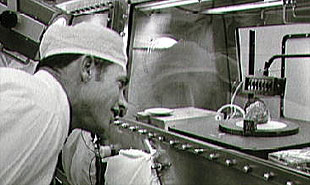
"I don't have any moon rock myself - it is just too important to the scientists! A lot of people ask, but we really don't. Maybe because we looked at the scientific output, and the interest of science in lunar materials. There would not be much I could do with it but look at it - and I could always go and look at one. But a scientist could spend their whole lives studying a little sliver of lunar rock."
With that, Dave Scott left the empty spacesuits and returned to his current, very different life.
The author extends his gratitude to Victoria Campbell and Michael Orenstein of Aurora Galleries International as well as Colin Burgess for their assistance with this article. |
back to News

© 2023 collectSPACE.com All rights reserved.
Questions? E-mail contact@collectspace.com

|
|

|
References:
Frank Borman with Robert Serling, Countdown, Morrow, 1988.
Michael Cassutt, Who's Who In Space: The International Space Year Edition, Macmillan, 1999.
Eugene Cernan and Don Davis, The Last Man on the Moon, St. Martin's, 1999.
Michael Collins, Carrying The Fire, Farrar, Straus and Giroux, 1974.
Michael Collins, Liftoff, Grove, 1988.
Walter Cunningham, The All-American Boys, Macmillan, 1977.
Tim Furniss, One Small Step, Foulis, 1989.
Virgil "Gus" Grissom - Gemini, Macmillan, 1969.
Chris Kraft, Flight: My Life In Mission Control, Dutton, 2001.
Gene Kranz, Failure Is Not An Option, Simon & Schuster, 2000.
Donald "Deke" Slayton with Michael Cassutt, Deke!, Forge, 1994.
|

|


 I met with Scott last April at the Museum of Flying in Santa Monica, California, where he was a guest at the first space memorabilia auction of Aurora Galleries International. Along with a number of other astronauts and cosmonauts, Scott was selling items of his own, such as flags, patches and medallions flown on his missions, his Apollo 15 EVA suit nametag, a Lunar Rover license plate and even the communication headset that he wore on the lunar surface. I asked him what made him decide to part with these objects at this point.
I met with Scott last April at the Museum of Flying in Santa Monica, California, where he was a guest at the first space memorabilia auction of Aurora Galleries International. Along with a number of other astronauts and cosmonauts, Scott was selling items of his own, such as flags, patches and medallions flown on his missions, his Apollo 15 EVA suit nametag, a Lunar Rover license plate and even the communication headset that he wore on the lunar surface. I asked him what made him decide to part with these objects at this point.
 The son of an Air Force general, Scott earned a Masters' Degree in aeronautics and astronautics, specializing in interplanetary navigation, while training as an Air Force fighter pilot and test pilot. With the perfect background for the job, he was selected to join NASA in 1963 with the third group of astronauts. Very highly ranked by his peers, they described him as "All-American," and joked that Scott came closest to the public persona of the tall, rugged, patriotic cold-war hero - looking most like the movie version of a daring astronaut. Over thirty years later, Scott still has that air about him; although time has altered his features, he now bears a striking resemblance to another American icon, the actor Lee Marvin.
The son of an Air Force general, Scott earned a Masters' Degree in aeronautics and astronautics, specializing in interplanetary navigation, while training as an Air Force fighter pilot and test pilot. With the perfect background for the job, he was selected to join NASA in 1963 with the third group of astronauts. Very highly ranked by his peers, they described him as "All-American," and joked that Scott came closest to the public persona of the tall, rugged, patriotic cold-war hero - looking most like the movie version of a daring astronaut. Over thirty years later, Scott still has that air about him; although time has altered his features, he now bears a striking resemblance to another American icon, the actor Lee Marvin.
 "Gemini had a pretty good computer. For its day, it was a pretty spectacular spacecraft. But I had a lot of concern about the Agena. In those days, the hardware was very new, and there were a lot of things happening. We had to make the assumption that it was okay, but during the flight they did see some problems with it, or thought they did."
"Gemini had a pretty good computer. For its day, it was a pretty spectacular spacecraft. But I had a lot of concern about the Agena. In those days, the hardware was very new, and there were a lot of things happening. We had to make the assumption that it was okay, but during the flight they did see some problems with it, or thought they did."
 The docked spacecraft were in darkness, so it was only with instruments that Scott noticed they had yawed thirty degrees from their planned position. Armstrong also took a look, and confirmed this. Armstrong then moved the two spacecraft back into the correct position using Gemini's thrusters. However, as soon as he released the hand control, the docked spacecraft resumed their unwanted motion. With no telemetry information from Gemini or Agena available via Mission Control to help explain this, the astronauts had to analyze the problem on their own.
The docked spacecraft were in darkness, so it was only with instruments that Scott noticed they had yawed thirty degrees from their planned position. Armstrong also took a look, and confirmed this. Armstrong then moved the two spacecraft back into the correct position using Gemini's thrusters. However, as soon as he released the hand control, the docked spacecraft resumed their unwanted motion. With no telemetry information from Gemini or Agena available via Mission Control to help explain this, the astronauts had to analyze the problem on their own.





 "The turnaround had never been done before, manned or unmanned. There had never been a launch of the CSM and the LM before, so there had never been a transposition and docking. The only command modules that had flown were on 7 and 8, and neither of them had any docking capability. A lot of things had to go right to make it work. It did not go as expected - but it was not because of thruster switches, as it is told in some people's books. It was because somehow, during the sequence of shocks from launch through the separation of the Command Module from the adapter, the valves closed due to the shock. It was not the switches, because we checked the switches. Unfortunately, people thought when we got back down - and some books say this - that we had bumped the switches. No, the valves shut on those thrusters from the shock, as they found out later on. When we figured out what the problem was, we just cycled the switches, and they opened."
"The turnaround had never been done before, manned or unmanned. There had never been a launch of the CSM and the LM before, so there had never been a transposition and docking. The only command modules that had flown were on 7 and 8, and neither of them had any docking capability. A lot of things had to go right to make it work. It did not go as expected - but it was not because of thruster switches, as it is told in some people's books. It was because somehow, during the sequence of shocks from launch through the separation of the Command Module from the adapter, the valves closed due to the shock. It was not the switches, because we checked the switches. Unfortunately, people thought when we got back down - and some books say this - that we had bumped the switches. No, the valves shut on those thrusters from the shock, as they found out later on. When we figured out what the problem was, we just cycled the switches, and they opened."
 Although in a spacecraft with no heat shield, Schweickart felt safer than he did during altitude chamber tests in Houston. He found the LM to be crisply responsive to the controls, more so than the CSM - like the difference between a fighter and a transport plane. He preferred the uncluttered feel of the spacecraft, too, and the feeling of flying while standing up.
Although in a spacecraft with no heat shield, Schweickart felt safer than he did during altitude chamber tests in Houston. He found the LM to be crisply responsive to the controls, more so than the CSM - like the difference between a fighter and a transport plane. He preferred the uncluttered feel of the spacecraft, too, and the feeling of flying while standing up.
 "Apollo 15 was the first extended scientific exploration of the Moon. We had to - it became time to do that. Often I like to compare it to a holiday. If you have studied a holiday destination, you can really enjoy it when you get there because you know something more about it than just the name. We had spent a lot of time studying the Moon, studying geology, and therefore we really enjoyed the scientific exploration as well as the scenery."
"Apollo 15 was the first extended scientific exploration of the Moon. We had to - it became time to do that. Often I like to compare it to a holiday. If you have studied a holiday destination, you can really enjoy it when you get there because you know something more about it than just the name. We had spent a lot of time studying the Moon, studying geology, and therefore we really enjoyed the scientific exploration as well as the scenery."

 "It's a spectacular scene. The Moon itself is colorless, except for the shades of gray and black. You live on a planet with a black sky, no atmosphere. But it is a beautiful, marvelous place, especially if you understand where you are going. It really reminds you of how important the Earth is - it illustrates the uniqueness of the Earth and its importance to mankind.
"It's a spectacular scene. The Moon itself is colorless, except for the shades of gray and black. You live on a planet with a black sky, no atmosphere. But it is a beautiful, marvelous place, especially if you understand where you are going. It really reminds you of how important the Earth is - it illustrates the uniqueness of the Earth and its importance to mankind.